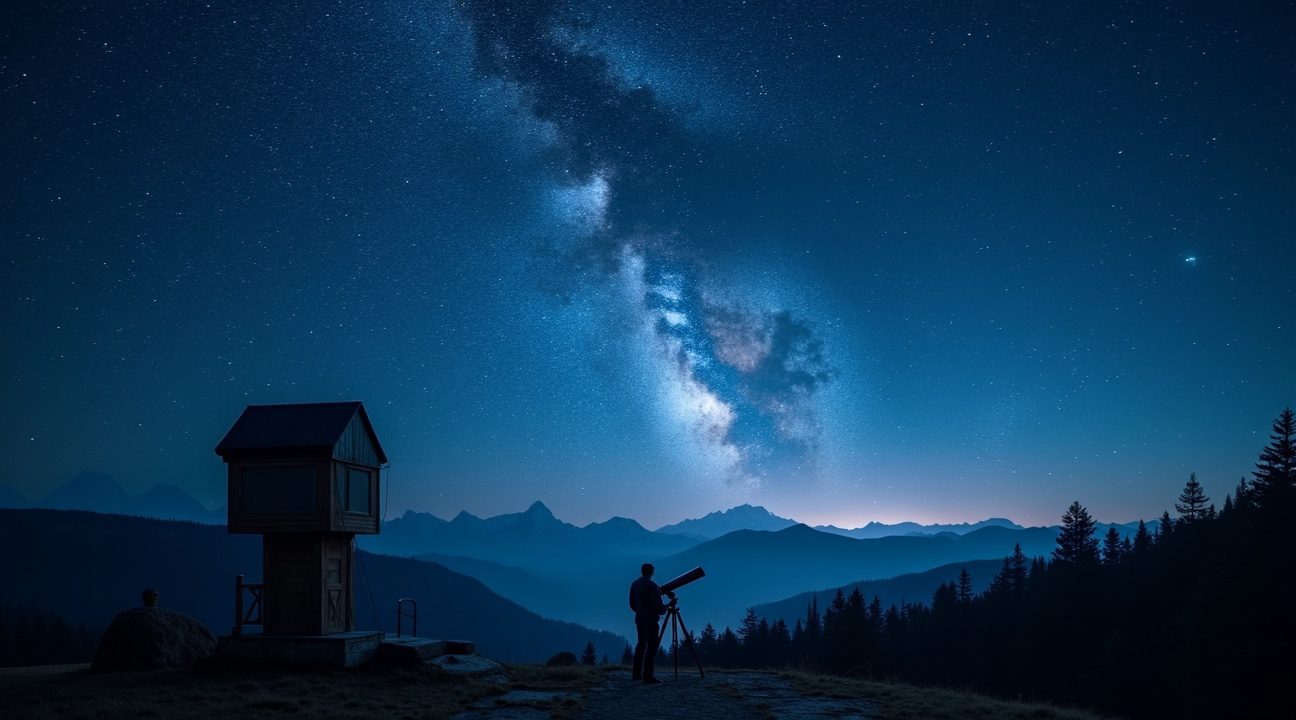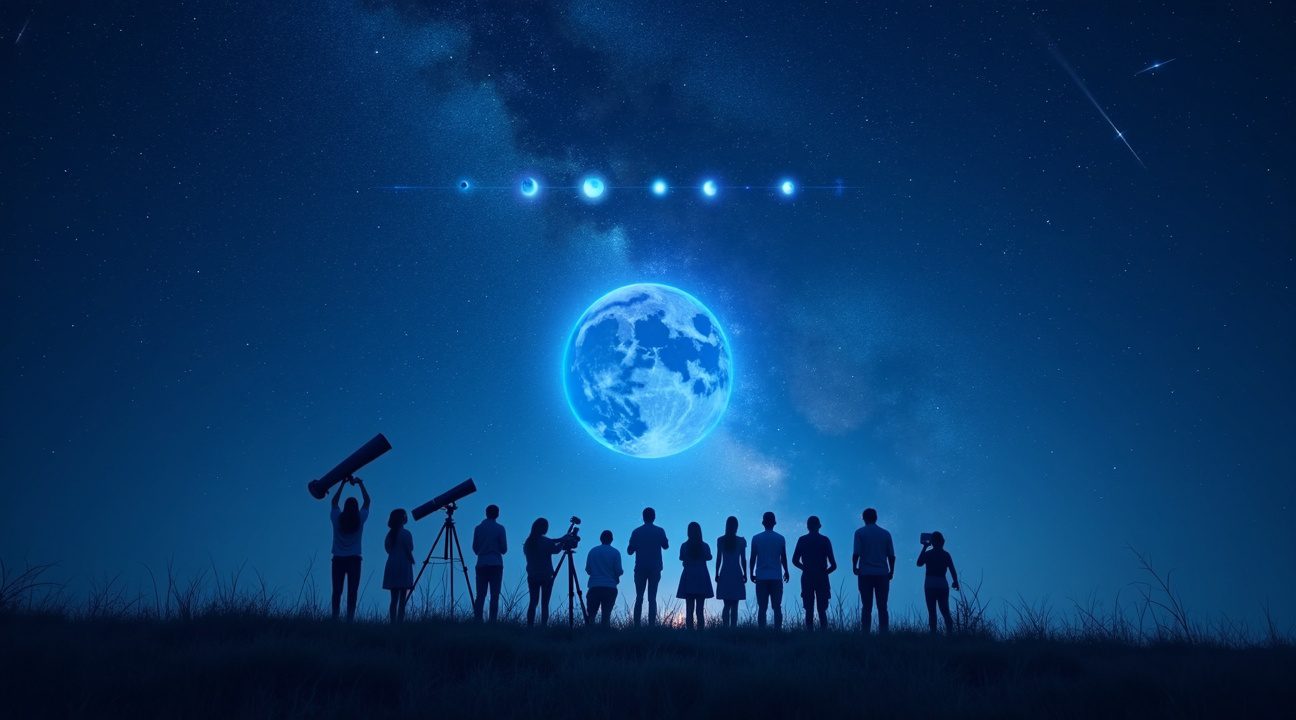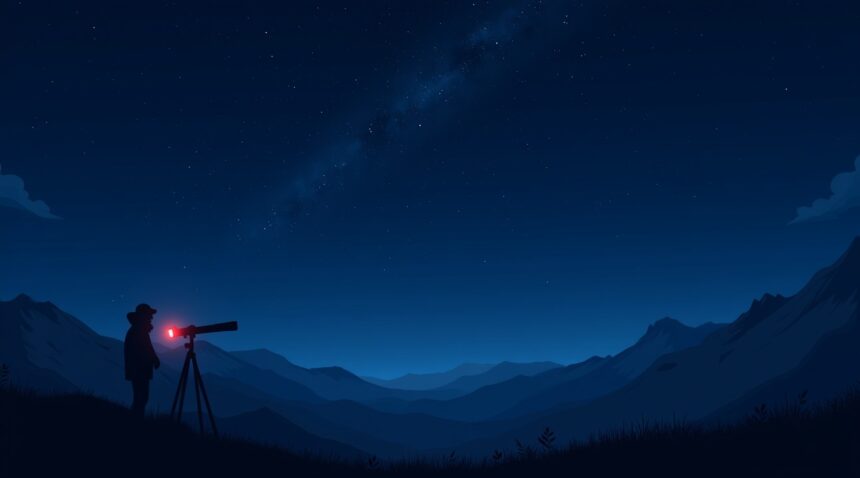A Black Moon represents the second new moon occurring within a single calendar month, and this rare astronomical event takes place approximately every 29 to 32 months, offering unique opportunities for stargazing and astrophotography.
Key Takeaways
- Occurrence Frequency: Black Moons happen roughly every 2.5 years when two new moons fall within one calendar month. The next occurrence is on December 30, 2024.
- Visibility: They remain completely invisible as they mark a standard new moon phase with the moon’s illuminated side facing away from Earth.
- Time Zone Influence: Due to time zone differences, a Black Moon may fall on different dates depending on geographic location.
- Rarest Instance: February’s Black Moon, when the month has no new or full moon, occurs about once every 19 years.
- Stargazing Ideal: These moonless nights offer exceptional conditions for observing faint stars and celestial phenomena.
Understanding the Black Moon
Astronomers primarily define a Black Moon as two new moons within a single calendar month, made possible because lunar cycles last about 29.5 days while months have 30 or 31 days. This mismatch allows for occasional double moon occurrences.
The term “Black Moon” arose in modern astronomy as a counterpart to the more familiar Blue Moon, which signifies the second full moon in a month. Unlike a Blue Moon that lights up the night sky, a Black Moon stays hidden, offering complete darkness.
Different Types of Black Moons
There are three main interpretations of the Black Moon:
- Monthly Black Moon: Two new moons in one calendar month — the most common type.
- Seasonal Black Moon: The third new moon in a season with four new moons.
- February Black Moon: No new or full moons in February — the rarest form, occurring about once every 19 years.
Geographic & Temporal Factors
Time zones can shift the calendar date of a lunar event. For instance, a new moon at 11 PM on January 31st in New York may register as February 1st in London. This affects whether a given lunar phase is seen as a Black Moon depending on your location.
Why Stargazers Love Black Moons
With no moonlight to outshine stars, Black Moons create the darkest sky conditions possible.
- Enhanced Visibility: Faint objects like nebulae, galaxies, and star clusters become clearer to the naked eye and telescopes alike.
- Optimal Photography: These nights are perfect for astrophotographers aiming to capture long-exposure images without lunar interference.
- December 2024 Event: The upcoming December 30, 2024 Black Moon occurs during winter in the Northern Hemisphere with long, dark nights for extended observation.
Planning for the Best Viewing Experience
- Prepare Ahead: Consider weather, light pollution, and local moonrise/moonset times to maximize your experience.
- Travel if Necessary: Urban light pollution may require traveling to darker areas for top-notch views.
- Summer Variant: The August 23, 2025 seasonal Black Moon provides warmer, more comfortable stargazing—even if nights are shorter.
Cultural & Scientific Significance
Different cultures interpret Black Moons in unique ways. Some associate them with spiritual or mystical meanings, while astronomy emphasizes their value for scientific observation. Beyond myth, these predictable events highlight the precise interplay between lunar cycles and our calendar.
Black Moons are a fascinating reminder of the seamless relationship between Earth’s orbit and timekeeping. These celestial alignments, calculated decades in advance, enhance our appreciation for the rhythms of the universe.
The Next Black Moon Arrives December 30, 2024 – Here’s What Makes It So Rare
Mark your calendars for December 30, 2024, when the next Black Moon graces our skies. This astronomical event represents the second new moon occurring within a single calendar month, creating a phenomenon that happens approximately every 29 to 32 months, or roughly once every 2.5 years.
The rarity of Black Moons extends beyond this single definition. Another type of Black Moon approaches on August 23, 2025, following the seasonal definition where a third new moon appears in a season containing four new moons. This seasonal variation occurs approximately every 33 months, making it even less frequent than the monthly version.
Time zone differences add another layer of complexity to Black Moon observations. A person in New York might witness a Black Moon on December 30th, while someone in London could experience the same lunar event on December 31st, technically eliminating the “Black Moon” classification for their location. These geographical variations mean that Black Moons aren’t universal experiences—they depend entirely on where you’re standing on Earth.
February’s Unique Lunar Absence
February presents the most extraordinary Black Moon scenario of all. This short month occasionally experiences no new moon or full moon whatsoever, creating a complete lunar void that occurs roughly every 19 years. During these rare February events, the moon’s gradual movement away from Earth plays a subtle role in the precise timing of these cycles.
The frequency of Black Moons mirrors that of blue moons, debunking any notion that one phenomenon occurs more often than the other. Both events share similar mathematical patterns, occurring with predictable regularity that astronomers can calculate decades in advance. Modern space missions, including recent achievements like India’s Chandrayaan-3 launch, continue to enhance our understanding of lunar cycles and their variations.
Ambitious lunar projects, such as Dubai’s massive moon project, demonstrate humanity’s fascination with our celestial neighbor and these rare astronomical events. Black Moons serve as perfect opportunities for stargazing since the absence of moonlight creates darker skies, revealing fainter stars and deep-space objects that typically remain hidden.
I recommend planning your December 2024 and August 2025 viewing sessions in advance, as these Black Moon events won’t return in the same form for several years. Amateur astronomers should take advantage of the enhanced darkness these new moons provide, making them ideal times for telescope observations and astrophotography sessions.

What Exactly Is a Black Moon and Why You Won’t See Anything in the Sky
A Black Moon sounds mysterious and dramatic, but it’s simply a term used in popular astronomy that lacks official recognition from scientific communities. I find it fascinating that something with such an ominous name actually refers to perfectly ordinary lunar phenomena that happen regularly.
The most widely accepted definition describes a Black Moon as the second new moon occurring within a single calendar month. This happens because the lunar cycle runs approximately 29.5 days, which doesn’t align perfectly with our calendar months. When a new moon occurs early in a 30 or 31-day month, there’s enough time for another complete lunar cycle before the month ends.
Another accepted definition identifies a Black Moon as the third new moon in a season containing four new moons instead of the typical three. This situation arises from the mismatch between lunar cycles and our calendar year structure. Occasionally, the timing creates an extra new moon within the three-month seasonal period.
Less commonly, astronomers apply the Black Moon label to a February that contains neither a new moon nor a full moon. February’s shorter length makes this possible since it’s the only month shorter than a complete lunar cycle of 29.5 days.
Why Black Moons Remain Invisible
Despite the dramatic terminology, observers won’t witness any spectacular celestial display during a Black Moon. The event remains completely invisible because it’s fundamentally just another new moon. During any new moon phase, the Moon’s sunlit side faces away from Earth, leaving the side visible to us in complete darkness.
I can’t emphasize enough that nothing changes about the Moon’s actual appearance during a Black Moon. The lunar surface looks exactly the same as during any other new moon — which is to say, you can’t see it at all. No special viewing equipment will reveal anything different, and no enhanced darkness occurs in the night sky.
The significance exists purely in calendar tracking and astronomical record-keeping. Amateur astronomers and lunar enthusiasts might mark these occasions for their relative rarity, but the Moon itself behaves exactly as it does during any new moon phase. Modern space missions like India’s Chandrayaan-3 help us understand that lunar phases depend entirely on the Moon’s position relative to Earth and the Sun, regardless of what we choose to call them.
Black Moons occur roughly every 32 months on average, though the exact timing varies based on which definition you use. The calendar-based nature of these events means different time zones might experience them on different dates, adding another layer of complexity to pinpointing when they occur.
Understanding Black Moons requires recognizing them as calendar curiosities rather than astronomical phenomena. They represent the interesting ways our human-made calendar systems interact with natural lunar cycles. The Moon’s gradual movement away from Earth over geological time doesn’t affect these monthly patterns significantly.
Professional astronomers rarely use the term “Black Moon” in scientific literature, preferring more precise descriptions of lunar phases and cycles. The term gained popularity through astronomy enthusiasts and media coverage seeking to highlight relatively uncommon calendar alignments.
For those hoping to observe something special during a Black Moon, the best approach involves appreciating the darkness itself. With no moonlight illuminating the sky, these nights offer excellent conditions for viewing faint stars, galaxies, and other deep-space objects that become washed out during brighter lunar phases.
The next time someone mentions a Black Moon approaching, remember that it’s simply a new moon with a more intriguing name. Projects like Dubai’s plans for lunar development might eventually give us new perspectives on these natural cycles, but for now, Black Moons remain invisible events marked only by their calendar significance.
The Calendar Mathematics Behind Black Moons
I find the mathematical precision behind black moon occurrences fascinating because it reveals how our calendar system creates these rare astronomical events. The lunar month spans approximately 29.5 days, which means twelve complete lunar cycles total about 354 days. This falls eleven days short of our standard 365-day calendar year, creating an inherent mismatch that makes black moons possible.
How Monthly Black Moons Form
This calendar discrepancy occasionally produces scenarios where two new moons appear within a single calendar month. Since most months contain 30 or 31 days, they can accommodate two complete lunar cycles when the timing aligns perfectly. I observe this happening when a new moon occurs early in a month—typically within the first few days—allowing enough time for the lunar cycle to complete and reset before the month ends.
The mathematics become even more intriguing when I consider seasonal black moons. Astronomical seasons contain approximately 91 to 94 days, which normally accommodate three new moons. However, the 11-day annual discrepancy between lunar and calendar years occasionally allows four new moons to fit within one season, making the fourth new moon a black moon.
February’s Unique Position
February presents the most unusual mathematical scenario because it’s the only month shorter than a complete lunar cycle. I’ve discovered that the moon’s gradual movement away from Earth doesn’t significantly affect these calculations on human timescales, but February’s brevity creates possibilities for the month to be “skipped” entirely by lunar phases.
When January ends with a new moon occurring in its final days, the next new moon might not arrive until March, leaving February without any new moon at all. This represents one of the rarest types of black moon events, occurring roughly once every 19 years.
The mathematical precision required for these alignments explains why black moons capture so much attention. Unlike planned lunar missions that scientists can schedule years in advance, black moons emerge from the natural interplay between lunar cycles and human calendar systems. Even ambitious projects like Dubai’s massive moon construction can’t replicate the mathematical elegance that creates these naturally occurring phenomena.
I calculate that monthly black moons appear roughly every 32 months on average, while seasonal black moons occur approximately every 33 months. These frequencies vary slightly due to the complex interactions between leap years, varying month lengths, and the precise timing of lunar cycles.

Black Moon vs Blue Moon: The Folklore Twins of Lunar Events
Black Moons and Blue Moons share an interesting relationship as the folklore twins of lunar events, each representing opposite ends of the lunar cycle spectrum. While both phenomena capture public imagination, they differ significantly in their characteristics and visibility.
Definition Differences Between the Two Phenomena
The primary distinction lies in their lunar phases and timing patterns. A Black Moon refers to the second new moon occurring within a single calendar month, while a Blue Moon represents the second full moon in the same timeframe. Seasonally speaking, astronomers define a Black Moon as the third new moon out of four in a single season, contrasting with a Blue Moon being the third full moon in a season containing four full moons.
These definitions create fascinating parallels between the two events. Both phenomena follow similar timing patterns, appearing approximately every 29–33 months. This consistency stems from the lunar cycle’s 29.5-day duration, which occasionally allows two complete cycles to fit within a 30 or 31-day month.
Visibility and Observation Contrasts
The most striking difference between these lunar twins becomes apparent during observation attempts. Black Moons remain completely invisible to the naked eye because they occur during the new moon phase, when the moon sits between Earth and the sun with its illuminated side facing away from us. This invisibility adds to the mystique surrounding Black Moon events, making them seem more mysterious than their blue counterparts.
Blue Moons, conversely, appear fully illuminated and shine brightly in the night sky. Observers can easily spot these events without any special equipment, making them more accessible to casual stargazers. The moon’s gradual movement away from Earth doesn’t significantly impact the visibility of either phenomenon.
Neither Black Moons nor Blue Moons hold official scientific classification status. Astronomers consider both terms folklore or popular media terminology rather than formal astronomical designations. Despite their unofficial status, these events continue to fascinate both amateur and professional observers.
Understanding these distinctions helps clarify common misconceptions about lunar phenomena. While lunar missions focus on scientific exploration rather than folklore events, comparing Black and Blue Moons provides valuable context for appreciating the moon’s regular cycle variations. Both phenomena remind us that even familiar celestial events can surprise us with their timing and rarity.
Why Black Moons Matter Despite Having No Scientific Significance
The term “Black Moon” carries no weight in formal astronomical circles, yet it has captured the imagination of the public and mass media in remarkable ways. I find it fascinating how this designation emerged from popular culture rather than scientific necessity, highlighting the human tendency to create meaning from celestial patterns.
The surge in Black Moon terminology occurred during the early 21st century, coinciding with increased access to astronomical information through the internet and social media platforms. This timing wasn’t coincidental—as space exploration missions like Chandrayaan 3 sparked renewed public interest in lunar phenomena, people began seeking names and explanations for events they observed in the night sky.
Unlike supermoons or lunar eclipses that produce visible changes observers can witness, Black Moon events offer no observable lunar features or astronomically meaningful effects. The moon doesn’t appear different, darker, or more mysterious during these periods. Instead, the significance lies entirely in calendar mathematics and the satisfaction of recognizing rare temporal patterns.
The Appeal of Astronomical Folklore
Black Moons remain part of popular astronomical folklore because they represent something uniquely human—the desire to categorize and name natural cycles. I observe this same phenomenon in how people celebrate meteor showers or track planetary alignments, even when these events don’t produce dramatic visual displays.
The rarity factor plays a crucial role in maintaining public interest. Several characteristics contribute to the Black Moon’s appeal:
- The mathematical precision required for the event creates a sense of cosmic timing
- Multiple definitions add layers of complexity that engage enthusiasts
- Calendar-based events feel more accessible than deep-space phenomena
- The name itself evokes mystery despite the mundane reality
- Social media amplifies awareness and creates shared experiences
This fascination reflects our species’ ancient relationship with lunar cycles, even as we’ve moved beyond relying on moon phases for practical purposes. The moon’s gradual movement away from Earth adds another dimension to our appreciation of current lunar phenomena.
The multiple definitions of Black Moons create additional complexity for those trying to track these events. Some definitions focus on calendar months, others on seasons, and still others on specific lunar cycle patterns. This variation means that determining when a Black Moon occurs requires careful attention to which definition applies and specific geographical considerations.
Time zones play a particularly important role in Black Moon timing. A new moon might occur late in the evening in one location but early the next morning elsewhere, potentially shifting the event from one month to another. I recommend that interested observers consult lunar calendars specifically created for their time zone to avoid confusion about local timing.
The practical reality is that Black Moon events serve as excellent opportunities for astronomical observation, even if the moon itself isn’t visible. The absence of moonlight creates ideal conditions for viewing faint celestial objects, meteor showers, and the Milky Way. Stargazers often plan special observation sessions during these periods, transforming an invisible lunar event into a celebration of dark skies.
Projects like Dubai’s massive moon construction demonstrate how lunar fascination continues to inspire human creativity and ambition, even in our modern technological age.
Black Moons ultimately matter because they connect us to celestial rhythms that have influenced human culture for millennia. While scientists may not recognize the term officially, these events provide accessible entry points for people developing interest in astronomy and lunar observation. They represent the democratization of astronomical knowledge, where anyone with a calendar can participate in tracking cosmic events.
The continuing popularity of Black Moon terminology suggests that humans will always find ways to create meaning from natural patterns, regardless of scientific validation. This tendency enriches our relationship with the cosmos and encourages closer attention to the subtle rhythms governing our solar system.

Popular Misconceptions About This Invisible Lunar Event
I’ve encountered countless questions about Black Moons that reveal deep confusion about this invisible lunar phenomenon. The dramatic name conjures images of supernatural events or spectacular celestial displays, yet the reality couldn’t be more different from these popular misconceptions.
Understanding the True Definition
Black Moons represent nothing more than specific timing patterns of new moon phases. The term typically describes the second new moon occurring within a single calendar month, though it can also refer to a seasonal third new moon out of four, or in rare cases, a February that lacks either a new or full moon phase entirely. I must emphasize that these definitions aren’t standardized astronomical terms—they’re informal designations rooted in folklore and modern popular culture.
Visual Expectations vs. Reality
The most persistent misconception I encounter involves expecting a visual spectacle. Unlike dramatic lunar events such as blood moons during total lunar eclipses, which paint our satellite in striking reddish hues, Black Moons offer absolutely no observable phenomena. The moon remains completely invisible during these events, hidden in Earth’s sky exactly as it does during every regular new moon phase.
Popular media has unfortunately perpetuated these misunderstandings by sensationalizing the term “Black Moon.” Articles often describe these events with ominous language that suggests rare, mystical occurrences worthy of observation. However, the moon simply continues its normal orbital cycle without any visual changes whatsoever.
I find that people frequently confuse Black Moons with other lunar phenomena precisely because of this misleading terminology. The dramatic name creates expectations of darkness or shadow that simply don’t materialize. Unlike eclipse events where Earth’s shadow creates visible effects, or supermoons where size differences become apparent, Black Moons remain entirely conceptual.
The confusion often stems from conflating different types of lunar events. While projects like Dubai’s massive moon capture public imagination with visible lunar themes, and missions such as Chandrayaan-3 advance our understanding of lunar science, Black Moons offer no such tangible experiences.
These misconceptions persist because astronomy enthusiasts naturally seek observable events they can witness and photograph. The disappointment of discovering that Black Moons provide no visual reward often leads to further confusion about their significance. Understanding that Black Moons are calendar curiosities rather than astronomical spectacles helps dispel these persistent myths about their nature and importance.

Sources:
space.com – “Black Moon: What is it and why does it occur?”
timeanddate.com – “When Is the Next Black Moon?”
Wikipedia – “Black moon”
space.com – “Black Moon vs. Blue Moon vs. Blood Moon: Nicknames, Explained”
livescience.com – “A rare ‘black moon’ rises this weekend”
Deep Creek Times – “Rare Black Moon coming August 22–23”


